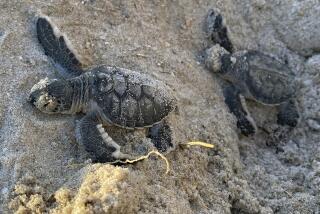Popular Pub Turtle Races Become Center of Slow-Track Social Whirl
Right before post time down at the track, the owners and trainers gather ‘round the turf club, drinking beer and swapping stories about some of the great races of all time.
Turtle racing is like that. Somehow you get hooked on it, and before you know it, you’re obsessed by it. You’re spending all of your free time building up a championship turtle-racing stable, collecting hundreds of turtle-racing trophies and thinking about putting your prize turtle out to stud.
And every Thursday, you’re down at the track outside Brennan’s Pub in Venice, talking about who was the greatest racer, scale for scale, that ever crawled across the circular green carpet. You’re wearing a jacket with a turtle insignia, a button that proclaims some form of “turtle power,” and handing out business cards hailing yourself as a bona fide turtle trader.
No Easy Task
And if you’re Jim (Duffy) Duffer, you’re asking yourself when it’s all going to end.
Duffer is one of the two men who first caught turtle fever, spread it, and now openly wonders if the shell game has gotten out of hand. He’s been the emcee for the turtle races for almost 13 years now--including many nights announcing in a velvet green tuxedo--and he acknowledges that the wear and tear has caught up with him.
“The whole thing is so dumb, I can’t explain it,” he said, surveying the 200 or so spectators who turned out at the track recently. “It’s almost like a cult thing, but that doesn’t even describe it. All I know is that I’ve been hung over almost every Friday for 13 years.”
At first, the idea of turtle racing was just a good promotional gimmick for Duffer’s friend, pub owner Ab Lawrence, who stole the idea from Zack’s Bar in Sausalito after a visit there in 1975. The whole thing was just a lark, Duffer said, but then the lines to get into the pub started going around the block on Thursdays and turtle fanatics started emerging from the shadows.
Hash Feder brags that he’s missed only five Thursdays in nearly seven years. He passes out business cards boasting “state of the art turtle racing.”
Trophy Hunter
Steve Wisolowski started out with one turtle and now carts about 25 to the track each week “in order to get more trophies.” So far, he’s won about 300 of them.
David Vincent personally caught the 30 or so turtles in his stable around his home turf in Baton Rouge, La. He has been doing it for eight years and says flatly: “Turtle racing is serious business.”
Dan Brown thinks that the whole idea is a joke. Fittingly, he’s named his turtle Touche, after a cartoon character. He and his friend, Mark Cosgrove, have been taking the turtle down to the bar in a small blue thermos for about six months now, watching Touche get trounced in race after race. Touche finished second once, but it was a fluke. The only way he might win is if the other turtles ran the race on their backs.
“Some people take it seriously, but they miss the point,” Brown said. “It’s funny, it’s entertaining, and it’s totally off the wall. How can you take turtle racing seriously?”
For Brown and the vast majority of the people who come out to watch the reptiles run, the real lure of turtle racing isn’t in the race.
While horse racing may be the sport of kings, turtle racing is the sport of singles. It’s an excuse to watch the races and play the field.
“Turtles are a great conversation piece,” Cosgrove explains. “They’re cute, like puppies, and girls are totally into it. They always want to know about your turtle.”
Said Duffer: “It’s like a social event. It’s beyond a bar scene. There’s a curiosity factor that brings people out. And they never go away.”
On a recent, chilly Thursday, the curious saw a blend of the wackiness and seriousness that typifies the world of competitive turtle racing. More than 100 turtles were entered in the contests, which are broken down into eight size categories, ranging from miniature to tortoise. Before the races, the turtles are kept in their “stables”--25- and 50-quart containers filled with water.
At 10 p.m., or whenever Duffer is ready to announce the races, the miniatures are taken out of their coolers and placed in the center of the green track, behind a metal cylinder. As with the other turtles, the owners rub their shells with their fingers, getting them ready for the races. Occasionally, an owner will throw a towel over one of them.
“It irritates them, makes them angry,” Brown said. “There are lots of little tricks like that. You get to know them the more you race.”
Then, as Duffer incites the crowd with expletives and bets owners cases of champagne that their losing turtles couldn’t win a race against a two-legged tortoise, the countdown begins. “ Cinco, quatro, tres, dos, uno “--and they’re off.
Well, sometimes they’re off. A lot of times, the turtles just sit there, looking like they’re waiting for goldfish from heaven. Then one of them will get the idea, and sprint for the finish line in a blowout. All the while, people scream and yell. And drink.
More to Read
Sign up for The Wild
We’ll help you find the best places to hike, bike and run, as well as the perfect silent spots for meditation and yoga.
You may occasionally receive promotional content from the Los Angeles Times.






